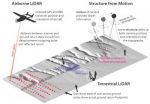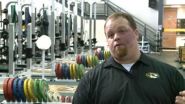(Press-News.org) INDIANAPOLIS -- Few people would guess that some of the most detrimental damage from a traumatic brain injury is to the lungs, but transplant specialists are keenly aware of this phenomenon. Indiana University research published Sept. 3 in Science Translational Medicine sheds light on the potentially lethal process.
Research conducted by an interdisciplinary team co-led by Fletcher A. White, Ph.D., the Vergil K. Stoelting Professor of Anesthesia, and David S. Wilkes, M.D., executive associate dean for research affairs and director of the Center for Immunobiology at the Indiana University School of Medicine, found evidence of fluid accumulation in the lung within hours after head trauma. The fluid limits the ability of the lung to oxygenate the bloodstream; this is particularly relevant in the case of a donor lung, which may become unsuitable for transplantation. Signs of the fluid leakage in the lungs are clearly evident within four hours after the head injury, and at 24 hours, the lungs' ability to oxygenate the blood stream is reduced nearly 80 percent.
The majority of lungs used in transplantation are procured from brain dead donors, of which between 40 and 70 percent have sustained traumatic brain injury. Since only 15 to 20 percent of all lungs evaluated are deemed appropriate for transplant, there is clearly an opportunity to better prepare donor lungs, particularly those whose death was caused by traumatic brain injury, said Dr. White, who also is a professor of pharmacology and toxicology and ophthalmology at the IU School of Medicine.
"There are three common causes of brain death among lung donors: traumatic brain injury, stroke and anoxic brain injury," said Daniel Weber, M.D., M.S., a surgical resident in the IU Department of Surgery and a postdoctoral fellow in the IU Center for Immunobiology. "Of those three mechanisms, people who receive lung transplants from donors who suffered traumatic brain injury generally fare worse. Considering that these are generally younger healthy lungs, understanding why such lungs are more damaged after head trauma was the impetus for this study."
"There's been a lingering question about brain injury and its relationship to the lungs," said Adam Gracon, M.D., Pharm.D., a resident in the IU Department of Surgery and a postdoctoral research fellow in the IU Center for Immunobiology. "In the medical literature, people have realized this is applicable to lung transplantation. There's been clinical evidence that transplants from traumatic brain injured donors don't do as well and the recipients don't do as well, but the reasons for impaired function were not known until now."
Following injury, an inflammatory cascade occurs involving a molecule named HMGB1, which is released into the blood stream following head trauma. From there, HMGB1 travels to the lung, where it can attach to its receptor, known as RAGE.
"The lungs have an abundance of the RAGE, so they are particularly susceptible to this inflammatory process after head trauma," Dr. Weber said.
What the IU researchers wanted to determine was how brain injury is tied to lung injury and the pathway that causes the inflammatory process to become active in the lungs. The most likely candidates were narrowed down to the HMGB1-RAGE pathway.
The RAGE receptor was genetically eliminated from some mice. The mice with and without RAGE were then subjected to a controlled brain injury. The researchers found that the mice without the RAGE receptor did not develop the acute lung injury, but the mice with the receptor developed increased levels of HMGB1 and inflammatory lung injury.
Dr. Wilkes, in collaboration with the IU Health Lung Transplant Program, has developed a biobank of blood and tissue samples from lung transplant donors and recipients. A review of these samples and patient outcomes confirmed that higher HMGB1 levels in donors were associated with poorer short-term outcomes in transplant recipients.
The researchers are optimistic that, by identifying a therapeutic target for the traumatic brain injury-induced lung impairment, the scarce donor pool of lungs may expand and recipient outcomes will improve.
INFORMATION:
This research was funded by National Institutes of Health grants NHLBI R01 HL096845, and NIAID P01AI084853, NIDDK R01 DK100905, and funding from the Indiana Spinal Cord and Brain Injury Research Fund.
IU researchers isolate process that damages lungs of donors with traumatic brain injury
2014-09-03
ELSE PRESS RELEASES FROM THIS DATE:
Is type 2 diabetes 'diabetes' as currently understood?
2014-09-03
The current way of diagnosing type-2 diabetes using blood glucose levels needs to be revised, research by scientists from The University of Manchester and King's College London suggests.
The findings, published in the journal PLOS ONE today (3 September), show the current method of diagnosis - using blood glucose levels - means patients are diagnosed too late so that their blood vessels may already be damaged.
Type 2 diabetes, which affects over 90% of all adults with diabetes, often leads to heart damage and blood vessel problems in the brain, eyes and kidneys. It ...
Biodiversity in the balance
2014-09-03
A new study calls into question the evolutionary stability of an ecological explanation of biodiversity.
The study, published in the journal PLOS ONE, brings together evolutionary theory and ecology to explore one of the big questions in ecology: How is biodiversity developed and maintained?
"This is a fundamental question if we want to protect biodiversity—what exactly do we need to protect?" says IIASA Evolution and Ecology Program Director Ulf Dieckmann, who led the study together with Florian Hartig from the University of Freiburg, collaborating with colleagues from ...
Penn study demonstrates wearable sensors to detect firearm use
2014-09-03
A new study from the University of Pennsylvania demonstrates that wearable sensors could one day transform the correctional system by tracking gun use by community-based offenders, who account for a disproportionate share of fatal and non-fatal shootings.
Currently, detecting and deterring this type of crime can be challenging in the absence of reliable evidence that a particular community-supervised offender illegally used a firearm.
In the study, published this week in the journal PLOS ONE, Charles Loeffler, an assistant professor of criminology at Penn, demonstrates ...
Widely used depression drug associated with dental implant failure
2014-09-03
Alexandria, Va., USA – The International and American Associations for Dental Research (IADR/AADR) have published a paper titled "SSRIs and the Risk of Osseointegrated Implant Failure – A Cohort Study." Selective Serotonin Reuptake Inhibitors (SSRIs), the most widely used drugs for the treatment of depression, have been reported to reduce bone formation and increase the risk of bone fracture. Since osseointegration is influenced by bone metabolism, this study investigates the association between SSRIs and the risk of failures in osseointegrated implants. The manuscript, ...
Story from the Department of Energy's Oak Ridge National Laboratory, Sept. 2014
2014-09-03
To arrange for an interview with a researcher, please contact the Communications staff member identified at the end of each tip. For more information on ORNL and its research and development activities, please refer to one of our media contacts. If you have a general media-related question or comment, you can send it to news@ornl.gov.
OPTICS – Precision projectile tracker …
Rifle optical sighting systems with a 19th century heritage could blast into modern times with a laser-based bullet tracking system being developed by a team led by Slobodan Rajic of Oak Ridge National ...
Trouble starting a task? Perception of time may be the problem, study finds
2014-09-03
Completing tasks and crossing them off the ubiquitous "to-do" list is a great feeling. But what about those nagging tasks we keep putting off? What's the difference between those jobs that get completed and those that do not?
The answer may be our perception of time, according to new research by Yanping Tu, a doctoral candidate at the University of Chicago's Booth School of Business.
The study, "The Categorization of Time and Its Impact on Task Initiation," recently published in the Journal of Consumer Research, finds that people are more likely to begin a job when, ...
How much gravity is enough?
2014-09-03
TORONTO, September 3, 2014 – Keeping upright in a low-gravity environment is not easy, and NASA documents abound with examples of astronauts falling on the lunar surface. Now, a new study by an international team of researchers led by York University professors Laurence Harris and Michael Jenkin, published today in PLOS ONE, suggests that the reason for all these moon mishaps might be because its gravity isn't sufficient to provide astronauts with unambiguous information on which way is "up".
"The perception of the relative orientation of oneself and the world is important ...
Team develops new, inexpensive method for understanding earthquake topography
2014-09-03
Boulder, Colo., USA – Using high-resolution topography models not available in the past, geologists can greatly enrich their research. However, current methods of acquisition are costly and require trained personnel with high-tech, cumbersome equipment. In light of this, Kendra Johnson and colleagues have developed a new system that takes advantage of affordable, user-friendly equipment and software to produce topography data over small, sparsely vegetated sites at comparable (or better) resolution and accuracy to standard methods.
Their workflow is based on structure ...
Study sets guideline for determining effectiveness of college football training methods
2014-09-03
VIDEO:
Athletic performance varies from day to day, which can make it difficult for strength and conditioning professionals to judge whether athletes' improvements are due to effective training. Now, University of...
Click here for more information.
COLUMBIA, Mo. –Athletic performance varies from day to day, which can make it difficult for strength and conditioning professionals to judge whether athletes' improvements are due to effective training. Now, University of Missouri ...
NIH-led scientists discover HIV antibody that binds to novel target on virus
2014-09-03
WHAT:
An NIH-led team of scientists has discovered a new vulnerability in the armor of HIV that a vaccine, other preventive regimen or treatment could exploit. The site straddles two proteins, gp41 and gp120, that jut out of the virus and augments other known places where broadly neutralizing antibodies (bNAbs) bind to HIV. This newly identified site on the viral spike is where a new antibody found by the scientists in an HIV-infected person binds to the virus. Called 35O22, the antibody prevents 62 percent of known HIV strains from infecting cells in the laboratory and ...

